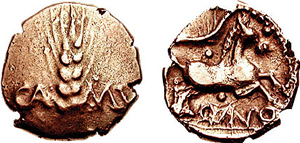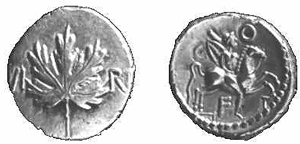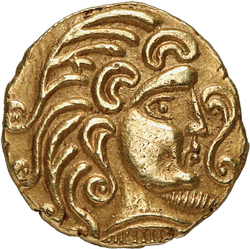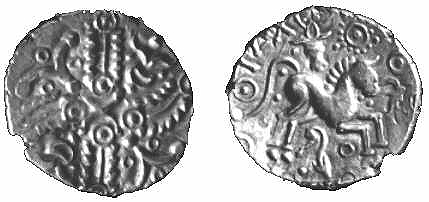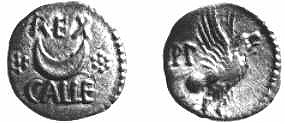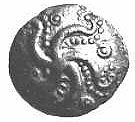|
Celtic Coins
The Celts of Europe got the idea of coins from the Greeks, as did the Romans. The first Celtic coins were minted in the 300s BC. The Celts of Britain started making their own coins around the time the Romans first visited Britain (Julius Caesar came in 55BC). In fact the reason was probably to pay the soldiers who were fighting Caesar's army.
Most Celtic coins are called 'staters', after the Greek coin of that name. They were made of gold, silver, and bronze, like Roman coins. Gold and silver coins were probably used as special gifts from kings and noblemen to their followers. Only the less valuable bronze coins were used to buy things, in the same way we use coins today.
The coins often had the name of a tribe or its king on one side. The inscription was in Latin, the language of the Romans - the Celts had no written language of their own. Both sides of the coins also had a picture - often a face, and horses were very popular too. The face may be a Celtic god. The style of these pictures is a little abstract - not as realistic as Roman art. Look at the examples on this page to see for yourself.
After Emperor Claudius conquered Britain in AD43, Roman coins began to be used in Britain and the Celts stopped producing their own.
Click here for a good website about Celtic coins: http://web.arch.ox.ac.uk/coins/ccindex.htm
Coin of Cunobellinus, king of the Catevellauni and the Trinovantes, AD10-43. It shows a wheat ear on one side and a horse on the other (with the letters CVNO for Cunobellinus)
Coin of King Verica, king of the Atrebates, AD10-30, with a leaf and a horse.
Coin of the Durotriges tribe, south-west Britain. What do you think it shows? |
Gold stater of the Parisii tribe in France: a lady or goddess
Other side of the Parisii coin: a horse
Stater of Tasciovanus, king of the area round St. Albans. On the right is a horse - what do you think the picture on the left is?
Coin of Eppillus, king of Calleva (Silchester). REX is Latin for king. On the left is a crescent - on the right an eagle.
Coin of the Durotriges. A starfish?
|
